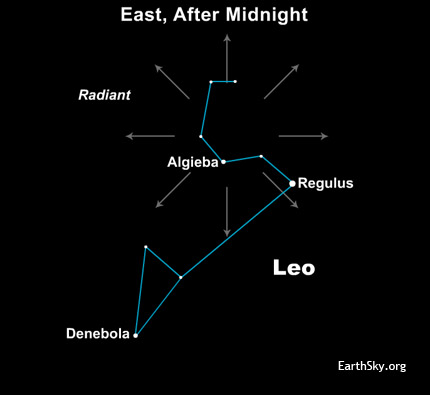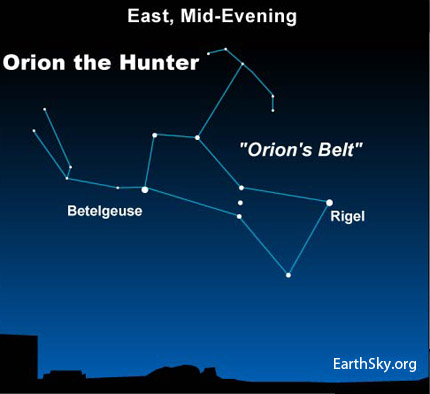
Image at top: A wide angle view of Leonid fireballs on November 17, 1998, via Juraj Toth.
The famous Leonid meteor shower is expected to be at its best in the predawn hours on Sunday, November 17, and Monday, November 18, 2018. We give the nod to Monday, November 18. But this year, in 2019, the waning gibbous moon will somewhat obstruct on this year’s production. In a dark sky, free of moonlight, you can typically see up to 10 to 15 meteors per hour at the shower’s peak.
Will you see what’s shown on the image at the top of this post? Thousands of meteors per hour? No. That image is from 1998, when the Leonids’ parent comet – Comet Temple-Tuttle – was nearby. The Leonids are famous for producing meteor storms when the comet is in our neighborhood, but no meteor storm is expected this year, only a modest 10 to 15 Leonid meteors per hour.

Radiant of the Leonid meteor shower near the star Algieba in the constellation Leo.
Here’s a tip: be aware of the rising time of the shower’s radiant point. As darkness falls in mid-November, the radiant point of the Leonid shower sits below your horizon, as seen from all parts of Earth. As the Earth turns, the constellation Leo the Lion – carrying the meteor shower radiant point – will rise over your eastern horizon around midnight (or around 1 a.m. at temperate latitudes in the Southern Hemisphere).
Around midnight, when the radiant point is at or near the horizon, the Leonid meteors are few and far between.
But the constellation Leo the Lion will climb upward in the sky during the hours after midnight. It reaches its highest point in the night sky just before dawn. That’s why you’ll see more meteors in the predawn sky. The higher that Leo appears in your sky, the more meteors you’re likely to see.
Just remember, you don’t have to locate a meteor shower radiant to watch the meteor shower. The meteors will appear in all parts of the sky. But if you trace the Leonid meteors backward, they appear to come from the constellation.
All is not lost in the evening hours, by the way! Evening is the best time to try to catch a rare earthgrazer – a sloow-moving and loong-lasting meteor that travels horizontally across the sky.
EarthSky lunar calendars make great gifts for astronomy-minded friends and family.
What else can you see on the night of the 2019 Leonids peak? From around the world, the constellation Orion the Hunter climbs above your eastern horizon around 9 p.m. That’s several hours before the constellation Leo enters the stage of sky around midnight.

Look for the constellation Orion the Mighty Hunter to adorn your eastern sky by around 9 p.m. Several hours thereafter, watch for the radiant of the Leonid meteor shower – the constellation Leo the Lion – to climb into your eastern sky around midnight. Read more.
The radiant for the Leonids is near the star Algieba in Leo. This is not Leo the Lion’s brightest star. That distinction goes to Leo’s star Regulus. Both Algieba and Regulus belong to a noticeable pattern on the sky’s dome, in the shape of a backwards question mark. This pattern is called “the Sickle.” The paths of Leonid meteors can be traced backwards to the Sickle pattern, which is a famous asterism – or noticeable star pattern – within the constellation Leo.
By the way, the Leonids are a fast-moving meteor stream. The meteors hit the Earth’s atmosphere at some 45 miles per second (72 km/second)! The Leonid meteor shower is known for having bright meteors or fireballs, which can punch into the atmosphere with the kinetic energy of a car hitting at 60 miles per second (nearly 100 km/second).
Bottom line: In 2019, the Leonid meteor shower is expected to be at its best before dawn on Sunday, November 17, and Monday, November 18. Usually the most meteors fall in the dark hours before dawn.
EarthSky’s top 10 tips for meteor-watchers
EarthSky’s meteor shower guide for 2019
Donate: Your support means the world to us
from EarthSky https://ift.tt/2qX93WB

Image at top: A wide angle view of Leonid fireballs on November 17, 1998, via Juraj Toth.
The famous Leonid meteor shower is expected to be at its best in the predawn hours on Sunday, November 17, and Monday, November 18, 2018. We give the nod to Monday, November 18. But this year, in 2019, the waning gibbous moon will somewhat obstruct on this year’s production. In a dark sky, free of moonlight, you can typically see up to 10 to 15 meteors per hour at the shower’s peak.
Will you see what’s shown on the image at the top of this post? Thousands of meteors per hour? No. That image is from 1998, when the Leonids’ parent comet – Comet Temple-Tuttle – was nearby. The Leonids are famous for producing meteor storms when the comet is in our neighborhood, but no meteor storm is expected this year, only a modest 10 to 15 Leonid meteors per hour.

Radiant of the Leonid meteor shower near the star Algieba in the constellation Leo.
Here’s a tip: be aware of the rising time of the shower’s radiant point. As darkness falls in mid-November, the radiant point of the Leonid shower sits below your horizon, as seen from all parts of Earth. As the Earth turns, the constellation Leo the Lion – carrying the meteor shower radiant point – will rise over your eastern horizon around midnight (or around 1 a.m. at temperate latitudes in the Southern Hemisphere).
Around midnight, when the radiant point is at or near the horizon, the Leonid meteors are few and far between.
But the constellation Leo the Lion will climb upward in the sky during the hours after midnight. It reaches its highest point in the night sky just before dawn. That’s why you’ll see more meteors in the predawn sky. The higher that Leo appears in your sky, the more meteors you’re likely to see.
Just remember, you don’t have to locate a meteor shower radiant to watch the meteor shower. The meteors will appear in all parts of the sky. But if you trace the Leonid meteors backward, they appear to come from the constellation.
All is not lost in the evening hours, by the way! Evening is the best time to try to catch a rare earthgrazer – a sloow-moving and loong-lasting meteor that travels horizontally across the sky.
EarthSky lunar calendars make great gifts for astronomy-minded friends and family.
What else can you see on the night of the 2019 Leonids peak? From around the world, the constellation Orion the Hunter climbs above your eastern horizon around 9 p.m. That’s several hours before the constellation Leo enters the stage of sky around midnight.

Look for the constellation Orion the Mighty Hunter to adorn your eastern sky by around 9 p.m. Several hours thereafter, watch for the radiant of the Leonid meteor shower – the constellation Leo the Lion – to climb into your eastern sky around midnight. Read more.
The radiant for the Leonids is near the star Algieba in Leo. This is not Leo the Lion’s brightest star. That distinction goes to Leo’s star Regulus. Both Algieba and Regulus belong to a noticeable pattern on the sky’s dome, in the shape of a backwards question mark. This pattern is called “the Sickle.” The paths of Leonid meteors can be traced backwards to the Sickle pattern, which is a famous asterism – or noticeable star pattern – within the constellation Leo.
By the way, the Leonids are a fast-moving meteor stream. The meteors hit the Earth’s atmosphere at some 45 miles per second (72 km/second)! The Leonid meteor shower is known for having bright meteors or fireballs, which can punch into the atmosphere with the kinetic energy of a car hitting at 60 miles per second (nearly 100 km/second).
Bottom line: In 2019, the Leonid meteor shower is expected to be at its best before dawn on Sunday, November 17, and Monday, November 18. Usually the most meteors fall in the dark hours before dawn.
EarthSky’s top 10 tips for meteor-watchers
EarthSky’s meteor shower guide for 2019
Donate: Your support means the world to us
from EarthSky https://ift.tt/2qX93WB

Aucun commentaire:
Enregistrer un commentaire